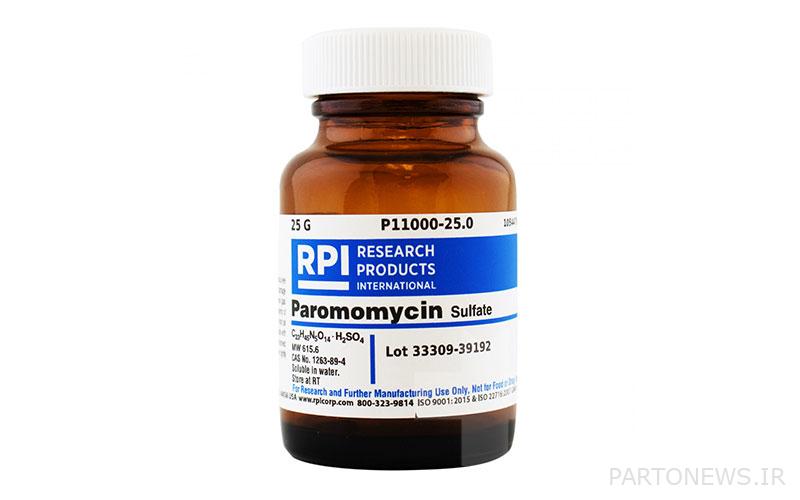Paromomycin (Paromomycin) and its uses and side effects

The problem of drug resistance against infections is one of the basic challenges in the field of medicine and public health in the world. As new microbes and viruses are discovered day by day, treating infections becomes a more complex task. In this situation, the urgency of developing and introducing new and more effective drugs against these microbes is felt more than ever. One of the popular drugs that has attracted a lot of attention in the fight against drug resistance of microbes is paromomycin. Paromomycin is a very effective antibiotic that has the power to fight many resistant microbes (bacteria and parasites) compared to conventional drugs.
What we read in this article
Pharmaceutical forms of paromomycin
- Sherbet
- 250 mg capsule
Uses of paromomycin capsules
This drug is used to treat a specific intestinal parasitic infection (amybiosis). This drug is known as an aminoglycoside antibiotic and works by stopping the growth of parasites in the intestine. Paromomycin may be used along with a special diet to treat a serious brain problem (hepatic encephalopathy). This condition occurs in people with liver disease and is caused by an excess of a certain natural substance (ammonia) in the body, which normally the liver gets rid of ammonia.
- The biggest changes that will happen in WhatsApp this yearFebruary 3, 2024
- Applications for locating family and friends on AndroidFebruary 2, 2024
Paromomycin helps treat hepatic encephalopathy by stopping the growth of certain bacteria in the gut that make ammonia. This antibiotic only treats parasitic and bacterial infections. It does not work for viral infections (such as colds, flu). Unnecessary use or incorrect use of any antibiotic can lead to a decrease in its effectiveness.
Uses of paromomycin in adults
- Intestinal amebiasis (Histolytica)
- Hepatic coma (complementary)
- Tapeworm (saginata/T. solium/D. latum/D. caninum)
- Dwarf tapeworm
- Cutaneous leishmaniasis (orphan)
Uses of paromomycin in children
- Dientamoeba Fragilis (a type of parasite)
- Intestinal amebiasis
- tapeworm
- Tapeworm (saginata/T. solium/D. latum/D. caninum)
- Dwarf tapeworm
- Histolytica
Pharmacological effects and mechanism of action of paromomycin drug
aminoglycoside; It interferes with bacterial protein synthesis by binding to S30 ribosomal subunits. This drug has antibacterial properties against pathogenic organisms in the digestive system. Finally, it is excreted through feces (100% as unchanged drug).
Paromomycin dosage
Take paromomycin by mouth with meals, usually 3 times a day (every 8 hours) as directed by your doctor. Dosage is based on weight, medical condition and response to treatment. For best results, take this antibiotic at regular intervals. Continue taking this medicine until the prescribed dose is finished, even if symptoms disappear after a few days. Early discontinuation of the drug may lead to the return of the infection. Tell your doctor if your condition persists or worsens.
Dosage of paromomycin capsules in adults
- In order to treat intestinal amoebiasis (Histolytica), 25 to 35 mg orally every 6 hours is prescribed daily for 5 to 10 days.
- Hepatic coma (supplementary), 4 mg orally daily in divided doses for 5-6 days.
- For the treatment of the intestinal parasite called Diantomoeba Fragilis, 20 to 30 mg (daily) orally every 8 hours is prescribed.
- Tapeworm (saginata/T. solium/D. latum/D. caninum), 11 mg/kg orally for 4 doses.
- Dwarf tapeworm is administered orally at 45 mg/kg daily for 5-7 days.
Time to use Paromomycin capsules in children
- To use different types of antibiotics in children, be sure to consult a doctor regarding the benefits and risks of use.
- For Histolytica, 25 to 35 mg/kg should be administered orally every 8 hours for 7 days. Also, 750 mg/m2 per day is divided for 5 days and for 6 hours.
- Dientamoeba fragilis parasite, 25 to 30 mg/kg daily for 7 days every 8 hours.
- Intestinal amebiasis, take 25 to 35 mg/kg daily every 8 hours for 5 to 10 days.
- Tapeworm (Hymenolepis nana), 45 mg/kg is taken orally for 5-7 days.
- Tapeworm (saginata/T. solium/D. latum/D. caninum), 11 mg/kg in 4 days divided and consumed.
- Dwarf tapeworm, 45 mg/kg daily orally for 5 to 7 days.
Precautions
Before using paromomycin, if you are allergic to this drug or other aminoglycoside antibiotics (such as gentamicin, tobramycin), avoid using it. This medicine may contain inactive ingredients that can cause allergic reactions or other problems. If you have special medical records, including severe liver and kidney disorders, heart problems, digestive problems, intestinal problems (such as obstruction, ulcers), etc., use this medicine with caution and a doctor’s prescription. During pregnancy, this drug should be used only if needed. Talk to your doctor about the risks and benefits.
- If you have had an unusual or allergic reaction to paromomycin or other antibiotics or drugs, foods, dyes, or preservatives, talk to your doctor about the risks of using this medicine.
- Before taking this drug, carefully check the drug interactions and cautions of the drug so that you do not have interactions or allergies.
- People with digestive problems such as stomach ulcers, esophageal ulcers, intestinal problems, etc. should take this medicine with food or a full glass of water with the doctor’s approval.
- Paromomycin may cause live bacterial vaccines (such as the typhoid vaccine) to not work as well. Tell your healthcare professional that you are using paromomycin before getting any immunizations or vaccinations.
- Before surgery, tell your doctor or dentist about all the medications you are taking (including prescription drugs, over-the-counter drugs, and herbal products).
- During pregnancy, this drug should be used only if needed.
- Long-term treatment may lead to fungal or bacterial infection.
- It should be used with caution in patients with renal failure or patients with ulcerative lesions of the intestine.
Paromomycin contraindications
- Hypersensitivity
- Ileus
Paromomycin capsule side effects
Nausea, vomiting, loss of appetite, abdominal muscle cramps, diarrhea and heartburn are some of the side effects of paromomycin capsules. If any of these effects persist or worsen, tell your doctor or pharmacist right away. Most people who use this drug do not experience serious side effects. Some of the serious side effects of this drug include greasy stools, ringing or ringing in the ears, hearing loss, dizziness, numbness and tingling of the skin, headache, seizures, muscle weakness, etc. Using this medicine for long or frequent periods may lead to oral thrush or a new vaginal yeast infection. Call your doctor if you notice white spots in your mouth, changes in vaginal discharge, or other new symptoms.
- diarrhea
- Abdominal cramps
- nausea
- Vomit
- cold burning
- Headache and dizziness
- exanthema
- urticaria
- itching
- steatorrhea
- Secondary enterocolitis
- Eosinophilia
- ototoxicity

Paromomycin drug interaction
If other drugs or herbal products are taken at the same time, the effects of some drugs can change. This process can increase the risk of serious side effects or cause your medication to not work properly. Your doctor or pharmacist can often prevent interactions by changing how you take your medications or by monitoring closely. To help your doctor and pharmacist provide the best care for you, make a list of the chemical and herbal medicines you use and show them. Except for digoxin, no specific drug interactions have been reported.
Use of paromomycin (paromomycin) during pregnancy and breastfeeding
Paromomycin drug is in group C in terms of risk during pregnancy to the fetus. It means that it can be used in special conditions and under the special supervision of a doctor. Animal studies on the use of this drug during pregnancy show a limited risk. Also, specific human studies regarding the benefits and risks of using this drug during pregnancy or breastfeeding are not available. Therefore, this drug should only be used with the approval and prescription of a doctor.
Paromomycin storage conditions
Paromomycin should be stored at room temperature and away from light. It is also important to keep all medications out of the reach of children, as many forms of medication (such as weekly tablets and eye drops, creams, patches, and inhalers) are not child-resistant and can be easily opened by young children. . Unnecessary medications should be disposed of in specific ways to ensure that pets, children, and other people cannot ingest them.
A final word about paromomycin capsules
In this article from Positive Green Online Pharmacy magazine, we introduced and reviewed Paromomycin drug as one of the effective antibiotics in the treatment of parasites and bacteria. Parasites and drug resistance are a serious challenge in the field of public health and medicine. Paromomycin has the ability to fight many bacteria and diseases, especially the parasite Dientamoeba Fragilis, tapeworm (T. saginata/T. solium/D. latum/D. caninum), intestinal amebiasis, etc.
Site source: Medscape

